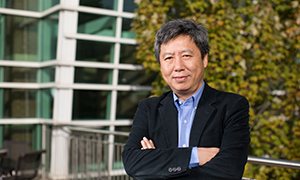Policy expert writes 'What Works May Hurt,' detailing side effects in education
LAWRENCE — Penicillin may help save your life, or it might cause a severe allergic reaction. An educational intervention may help students boost reading scores, but it may also make them hate reading. Side effects are a well-known phenomenon in medicine, but they exist in education as well. A University of Kansas professor has written a book exploring educational side effects, how they affect students and schools, and how addressing them could benefit the entire educational system.
 Yong Zhao, Foundation Distinguished Professor in the KU School of Education, has written “What Works May Hurt: Side Effects in Education.” The book argues that side effects are a real, common occurrence in education, even if they are not regularly talked about. Addressing them from the research stage to implementation in the classroom could help boost student achievement and prevent ideological wars that plague education policy.
Yong Zhao, Foundation Distinguished Professor in the KU School of Education, has written “What Works May Hurt: Side Effects in Education.” The book argues that side effects are a real, common occurrence in education, even if they are not regularly talked about. Addressing them from the research stage to implementation in the classroom could help boost student achievement and prevent ideological wars that plague education policy.
“When something is effective, it can also be effective at doing something bad, both in medicine and education,” Zhao said. “Education is not an averages game. What works for some will by definition not work for everyone. However, whenever we discover something good in education, we have a tendency to assume it works for everyone.”
In the book, Zhao provides evidence of popularly endorsed education strategies, policies and systems that actually do harm to students. The public is not told that school choice may help improve test scores for some students but possibly at the cost of the collapse of American public education, for one example. Similarly, East Asian nations are often pointed to as the gold standard in math education because of the high scores of their students on international tests. What goes unmentioned, however, is that research has shown students in those nations regularly have low confidence in their math ability, which can lead to reluctance to take jobs in math-related fields and other problems, Zhao points out.
One size will never fit all in education, and the East Asian situation is a prime example of prioritizing academic outcomes over personal confidence, Zhao said. A doctor would not prescribe the exact amount of medication to every single patient, yet educational approaches such as the Common Core that focus on math and reading tend to assume all students need the same level of instruction in those subjects.
Zhao encourages educators and parents to consider less-publicized, less-known or lower-effect strategies to help certain students and classrooms. Just as consumers are given information to help inform their choices about health care, so should they be given information on benefits, side effects and all consequences of educational approaches.
“We’re always looking for a panacea,” Zhao said. “If you are aware of the side effects, you can think of ways to mitigate them. We tend to ask, ‘Does this work?’ We should also ask, ‘If it’s yes, at what cost?’ Looking at side effects can also help stop some of the wars between different ideas and approaches in education as well.”
When approaches gain popularity, it is common for people to tout their benefits, but it is also frequent for people to argue against why they don’t work or are not as effective as claimed, Zhao writes. Even if they’re not using the term “side effects,” both sides of these ideological arguments are essentially debating what works and what hurts. That leads to pendulum swings in popular opinion and arguing about methods that could be avoided if side effects were considered from the beginning.
To that end, the book recommends researchers include possible downsides to educational strategies they are testing and promoting to assist school leaders, practitioners and consumers in implementing new educational strategies, interventions and practices. Zhao also cautions teachers, policymakers and parents to be more thoughtful and examine evidence when considering educational programs. Consumers could also make a difference by demanding more information on educational side effects. Pharmaceutical companies don’t report on the negative aspects of their medications voluntarily; they do so because government and consumers demanded the information, Zhao said.
The book’s recommendations are beneficial to teachers and those who inform education policy, who hold influence over future generations of students, scholars say.
“Yong Zhao has written a highly readable and important book about the side effects — the unintended consequences — of education reforms. Every educator and researcher should read this book and take its lessons to heart,” said Diane Ravitch, influential education researcher and professor at New York University.
While relying on statistical probability to determine which methods may help the most students does have value, it cannot be the sole approach to education, Zhao said. Students cannot be simply looked at as collateral damage of methods that work for most. Considering what will work for whom and the negative outcomes they may have for others can help the educational research field learn how best to help each student.
“I hope this book invites people to rethink education. We should treat all children as exceptions to the rule, and I hope this helps take educational research in a new direction,” Zhao said.